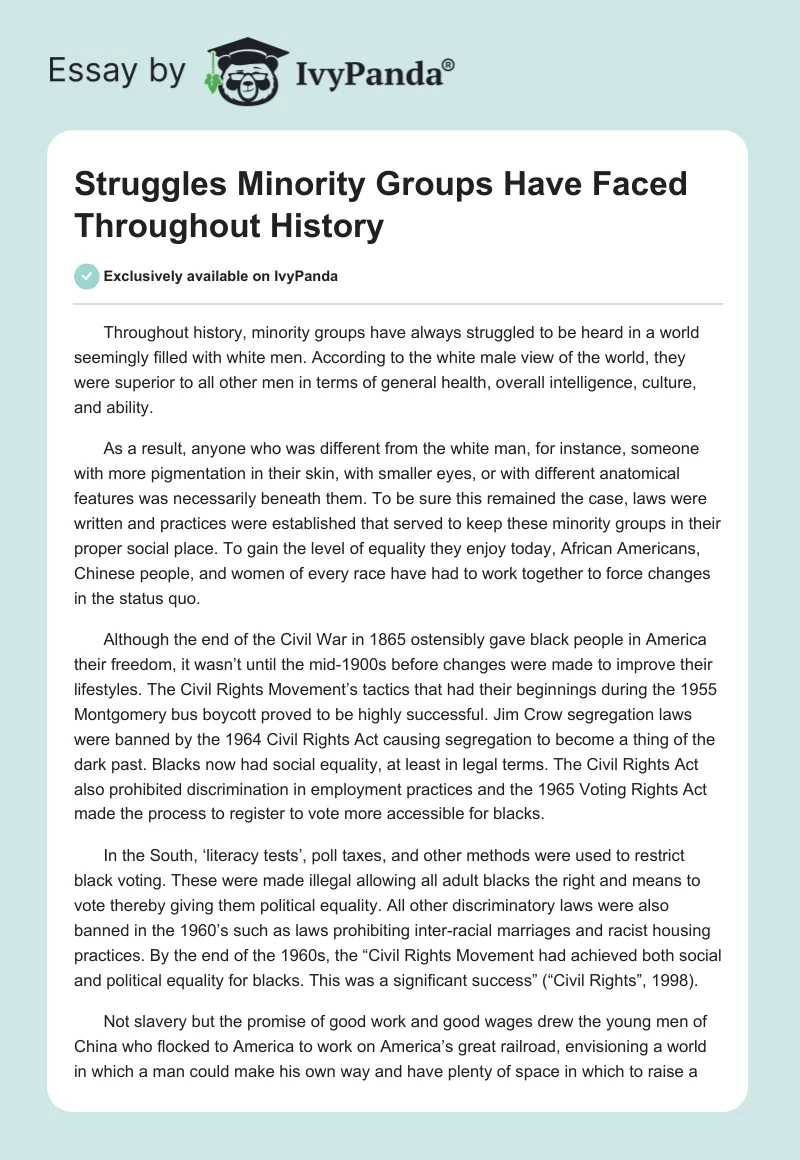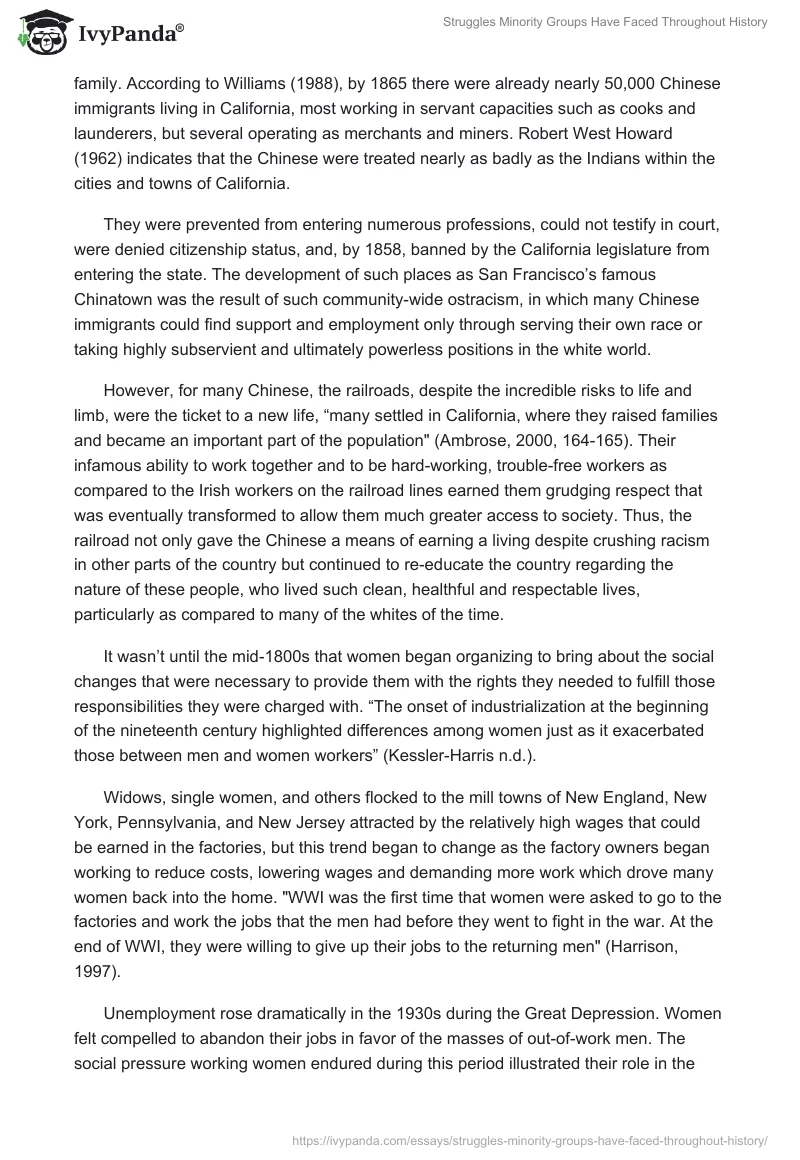Throughout history, minority groups have always struggled to be heard in a world seemingly filled with white men. According to the white male view of the world, they were superior to all other men in terms of general health, overall intelligence, culture, and ability.
As a result, anyone who was different from the white man, for instance, someone with more pigmentation in their skin, with smaller eyes, or with different anatomical features was necessarily beneath them. To be sure this remained the case, laws were written and practices were established that served to keep these minority groups in their proper social place. To gain the level of equality they enjoy today, African Americans, Chinese people, and women of every race have had to work together to force changes in the status quo.
Although the end of the Civil War in 1865 ostensibly gave black people in America their freedom, it wasn’t until the mid-1900s before changes were made to improve their lifestyles. The Civil Rights Movement’s tactics that had their beginnings during the 1955 Montgomery bus boycott proved to be highly successful. Jim Crow segregation laws were banned by the 1964 Civil Rights Act causing segregation to become a thing of the dark past. Blacks now had social equality, at least in legal terms. The Civil Rights Act also prohibited discrimination in employment practices and the 1965 Voting Rights Act made the process to register to vote more accessible for blacks.
In the South, ‘literacy tests’, poll taxes, and other methods were used to restrict black voting. These were made illegal allowing all adult blacks the right and means to vote thereby giving them political equality. All other discriminatory laws were also banned in the 1960’s such as laws prohibiting inter-racial marriages and racist housing practices. By the end of the 1960s, the “Civil Rights Movement had achieved both social and political equality for blacks. This was a significant success” (“Civil Rights”, 1998).
Not slavery but the promise of good work and good wages drew the young men of China who flocked to America to work on America’s great railroad, envisioning a world in which a man could make his own way and have plenty of space in which to raise a family. According to Williams (1988), by 1865 there were already nearly 50,000 Chinese immigrants living in California, most working in servant capacities such as cooks and launderers, but several operating as merchants and miners. Robert West Howard (1962) indicates that the Chinese were treated nearly as badly as the Indians within the cities and towns of California.
They were prevented from entering numerous professions, could not testify in court, were denied citizenship status, and, by 1858, banned by the California legislature from entering the state. The development of such places as San Francisco’s famous Chinatown was the result of such community-wide ostracism, in which many Chinese immigrants could find support and employment only through serving their own race or taking highly subservient and ultimately powerless positions in the white world.
However, for many Chinese, the railroads, despite the incredible risks to life and limb, were the ticket to a new life, “many settled in California, where they raised families and became an important part of the population” (Ambrose, 2000, 164-165). Their infamous ability to work together and to be hard-working, trouble-free workers as compared to the Irish workers on the railroad lines earned them grudging respect that was eventually transformed to allow them much greater access to society. Thus, the railroad not only gave the Chinese a means of earning a living despite crushing racism in other parts of the country but continued to re-educate the country regarding the nature of these people, who lived such clean, healthful and respectable lives, particularly as compared to many of the whites of the time.
It wasn’t until the mid-1800s that women began organizing to bring about the social changes that were necessary to provide them with the rights they needed to fulfill those responsibilities they were charged with. “The onset of industrialization at the beginning of the nineteenth century highlighted differences among women just as it exacerbated those between men and women workers” (Kessler-Harris n.d.).
Widows, single women, and others flocked to the mill towns of New England, New York, Pennsylvania, and New Jersey attracted by the relatively high wages that could be earned in the factories, but this trend began to change as the factory owners began working to reduce costs, lowering wages and demanding more work which drove many women back into the home. “WWI was the first time that women were asked to go to the factories and work the jobs that the men had before they went to fight in the war. At the end of WWI, they were willing to give up their jobs to the returning men” (Harrison, 1997).
Unemployment rose dramatically in the 1930s during the Great Depression. Women felt compelled to abandon their jobs in favor of the masses of out-of-work men. The social pressure working women endured during this period illustrated their role in the social order in the minds of both genders before WWII. However, not all women gave up their newfound independence after working for the men in WWII and the ones who returned to the home didn’t stay there for long.
The jobs may have been temporary but their new sense of identity and self-respect were not. Attitudes toward women in the workplace were changing in all sectors of society including the business community which needed increasing numbers of employees in the economic boom that followed the war. In 1960, more than double the percentage of married women worked than did in 1940 (Harrison, 1997).
In 1964, a major piece of legislation, Title VII of the Civil Rights Act, greatly enhanced women’s rights in the workplace. This Act precludes employers engaging in discriminatory practices, “to fail or refuse to hire or to discharge any individual, or otherwise to discriminate against any individual with respect to his compensation, terms, conditions, or privileges of employment, because of such individual’s race, color, religion, sex, or national origin” (U.S. Equal Employment Opportunity Commission, 1964).
Since the passage of this Act, women, and minorities have legal recourse against discrimination in the workplace with regards to promotions, hiring practices, dismissals, wages, training, working conditions, and benefit compensation. In other words, the Act equaled the playing field for women by allowing them the same legal right to work as men.
In all of the above cases, the minority group in question found it necessary to band together in unified efforts before attitudes and behaviors began changing. As small, disconnected communities of former slaves, the blacks were ineffective in gaining support or equality, but as these groups began working together, much positive change has been brought about. This was true for the Chinese and the women as well. Thus, equality seems to begin with equanimity.
Works Cited
Ambrose, Stephen E. Nothing Like It in the World: The Men Who Built the Transcontinental Railroad, 1863-1869. New York: Simon & Schuster, 2000.
“Civil Rights Movement, The.” (1998). Theale Green Community School. Berkshire. Web.
Harrison, Cynthia. “From the Home to the House: The Changing Role of Women in American Society.” USIA Electronic Journal. Vol. 2, N. 2, (1997). Web.
Howard, Robert West. The Great Iron Trail: The Story of the First Transcontinental Railroad. New York: Bonanza Books, 1962.
Kessler-Harris, Alice. “Women and the Work Force.” The Reader’s Companion to American History. Houghton Mifflin Company, (n.d.). Web.
U.S. Equal Employment Opportunity Commission. “Title VII.” Civil Rights Act. (1964). Web.
Williams, John Hoyt. A Great and Shining Road: The Epic Story of the Transcontinental Railroad. New York: Times Books (Random House), 1988.


